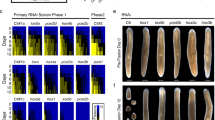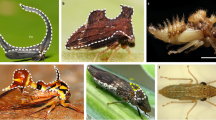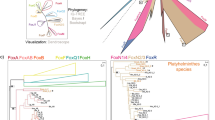Abstract
THE development of Drosophila is typical of the so-called long germband mode of insect development, in which the pattern of segments is established by the end of the blastoderm stage1,2. Short germband insects, such as the grasshopper Schistocerca americana, by contrast, generate all or most of their metameric pattern after the blastoderm stage by the sequential addition of segments during caudal elongation3. This difference is discernible at the molecular level in the pattern of initiation of the segment polarity gene engrailed4, and the homeotic gene abdominal-A (ref. 5). For example, in both types of insects, engrailed is expressed by the highly conserved germband stage4,6 in a pattern of regularly spaced stripes, one stripe per segment7–9. In Drosophila, the complete pattern is visible by the end of the blastoderm stage, although engrailed appears initially in alternate segments in a pair-rule pattern9–10 that reflects its known control by pair-rule genes such as even-skipped11*15. In contrast, in the grasshopper, the engrailed stripes appear one at a time after the blastoderm stage as the embryo elongates4. To address the molecular basis for this difference, we have cloned the grasshopper homologue of the Drosophila pair-rule gene even-skipped and show that it does not serve a pair-rule function in early development, although it does have a similar function in both insects during neurogenesis later in development.
This is a preview of subscription content, access via your institution
Access options
Subscribe to this journal
Receive 51 print issues and online access
$199.00 per year
only $3.90 per issue
Buy this article
- Purchase on Springer Link
- Instant access to full article PDF
Prices may be subject to local taxes which are calculated during checkout
Similar content being viewed by others
References
Ingham, P. Nature 335, 25–34 (1988).
Akam, M. Development 101, 1–22 (1987).
Sander, K. Adv. Insect Physiol. 12, 125–238 (1976).
Patel, N. H., Kornberg, T. B. & Goodman, C. S. Development 107, 201–212 (1989).
Tear, G., Akam, M. & Martinez-Arias, A. Development 110, 915–925 (1990).
Sander, K. Development 104, (suppl.) 112–121 (1988).
Kornberg, T., Siden, I., O'Farrell, P. H. & Simon, M. Cell 40, 45–53 (1985).
Fjose, A., McGinnis, W. & Gehring, W. J. Nature 313, 284–289 (1985).
DiNardo, S., Kuner, J., Theis, J. & O'Farrell, P. H. Cell 43, 59–69 (1985).
Weir, M. P. & Kornberg, T. Nature 318, 433–439 (1985).
DiNardo, S. & O'Farrell, P. H. Genes Dev. 1, 1212–1225 (1987).
Lawrence, P. A., Johnston, P., Macdonald, P. & Struhl, G. Nature 328, 440–442 (1987).
Macdonald, P., Ingham, P. & Struhl, G. Cell 47, 721–734 (1986).
Frasch, M., Hoey, T., Rushlow, C., Doyle, H. & Levine, M. EMB0 J. 6, 749–759 (1987).
Frasch, M., Warrior, R., Tugwood, J. & Levine, M. Genes Dev. 2, 1824–1838 (1988).
Doe, C. Q., Smouse, D. & Goodman, C. S. Nature 333, 376–378 (1988).
Thomas, J. B., Bastiani, M. J., Bate, C. M. & Goodman, C. S. Nature 310, 203–207 (1984).
Ruiz i Altaba, A. & Melton, D. A. Development 106, 173–183 (1989).
Bastian, H. & Gruss, P. EMBO J. 9, 1839–1852 (1990).
Dush, M. K. & Martin, G. M. Devl Biol. (in the press).
Ruiz i Altaba, A. & Melton, D. A. Cell 57, 317–326 (1989).
Ruiz i Altaba, A. & Melton, D. A. Trends Genet. 6, 57–64 (1990).
D'Esposito, M. et al. Genomics 10, 43–50 (1991).
Boncinelli, E., Simeone, A., Acampora, D. & Mavilio, F. Trends Genet. 7, 329–334 (1991).
Cavener, D. R. Nucleic Acids Res. 15, 1353–1361 (1989).
Grenningloh, G., Rehm, E. J. & Goodman, C. S. Cell 67, 45–57 (1991).
Snow, P. M. et al. Proc. natn. Acad. Sci. U.S.A. 85, 5291–5295 (1988).
Nilsson, B. & Abrahmsen, L. Meth. Enzym. 185, 144–161 (1990).
Koerner, T. J., Hill, J. E., Meyers, A. M. & Tzagoloff, A. Meth. Enzym. 194, 477–490 (1991).
Patel, N. H. et al. Cell 58, 955–968 (1989).
Author information
Authors and Affiliations
Rights and permissions
About this article
Cite this article
Patel, N., Ball, E. & Goodman, C. Changing role of even-skipped during the evolution of insect pattern formation. Nature 357, 339–342 (1992). https://doi.org/10.1038/357339a0
Received:
Accepted:
Issue Date:
DOI: https://doi.org/10.1038/357339a0
This article is cited by
-
A mosaic of conserved and novel modes of gene expression and morphogenesis in mesoderm and muscle formation of a larval bivalve
Organisms Diversity & Evolution (2022)
-
Expression of NK cluster genes in the onychophoran Euperipatoides rowelli: implications for the evolution of NK family genes in nephrozoans
EvoDevo (2018)
-
Ancient role of ten-m/odz in segmentation and the transition from sequential to syncytial segmentation
Hereditas (2017)
-
Establishment of molecular genetic approaches to study gene expression and function in an invasive hemipteran, Halyomorpha halys
EvoDevo (2017)
-
Regulation and function of odd-paired in Tribolium segmentation
Development Genes and Evolution (2017)
Comments
By submitting a comment you agree to abide by our Terms and Community Guidelines. If you find something abusive or that does not comply with our terms or guidelines please flag it as inappropriate.



